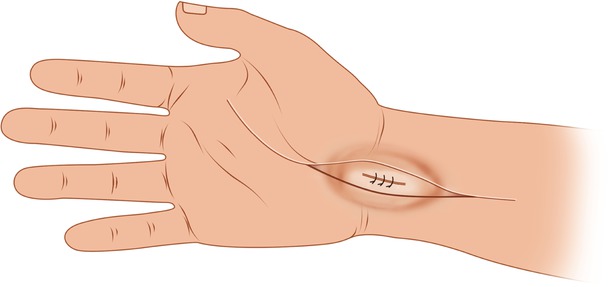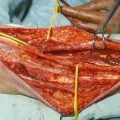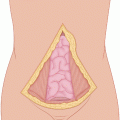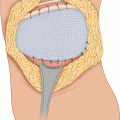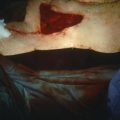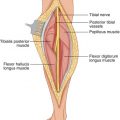(1)
State University of New York at Buffalo Kaleida Health, Buffalo, NY, USA
Large tumors in this area, especially if they extend into the joint, may require an amputation. Smaller tumors, however, may be dealt with using a more conservative, limb-preserving resection. In such cases, neoadjuvant or adjuvant chemoradiation may be helpful. The patient presented here initially underwent surgery elsewhere for a diagnosis of carpal tunnel syndrome. When a suspicious piece of tissue was found and removed, however, it was histologically diagnosed as synovial sarcoma. On the initial physical examination, there was no residual palpable mass. The patient wished to have limb salvage, accepting the higher risk of local recurrence rather than have an amputation as initial treatment.
The incision was started higher, with an ellipse made to include the previous incision and continued into the hand (Fig. 4.1). Flaps were raised medially and laterally (Fig. 4.2). There were no macroscopic suspicious findings at the exposed tissues. The palmaris longus was divided proximally and reflected distally (Fig. 4.3). The fascia covering the flexor tendons was mobilized toward the palm of the hand. The median nerve was exposed in its position posterior and slightly radial to the tendon of the palmaris longus. The flexor retinaculum was divided at its medial and lateral attachment and the palmar aponeurosis was dissected and removed in continuity (Fig. 4.4). Several frozen section biopsy specimens from the surgical bed showed no tumor. However, on the removed specimen, there was microscopic tumor extending close to the line of resection. The patient was given adjuvant postoperative radiation to a total of 6,000 rad, with adjuvant chemotherapy (Fig. 4.5). She remained disease-free for nearly 10 years, when relapse occurred in the same area with an aggressive sarcoma, which at this time was treated with amputation through the forearm.
